
Practice elucidates the theory. If on the one hand there are many books that talk about strategy, on the other hand there is still a lack of literature that in fact shows a clear orientation for strategic implementation in organizations. And it is at this point that most planning efforts fail.
One of the reasons for the failure of some managers is the separate understanding of areas such as strategic management, management by processes and management by competencies. If we think further, perhaps the source of the problem lies in the university itself, which tends to organize knowledge in a segmented way, by disciplines.
Due to constant failures in execution, researchers at the University of Texas created an integrated methodology to put strategic planning into practice without incurring the risks of segmentation. This is the proposal of the 5P’s Strategic Implementation Model, created by Mildred Golden Pryor, Donna Anderson, Leslie Toombs and John H. Humphreys.
“The implementation of the strategy must take into account the inexorably interconnected elements, such as culture, organization, people and systems. We also agree that it is necessary to go beyond verbiage to a more comprehensive and detailed outline to help those responsible for strategic execution. For this reason, we propose a broad interpretation that is oriented towards this process – the 5P’s model for implementing the strategy. ” – Pryor, Anderson, Toombs and Humphreys
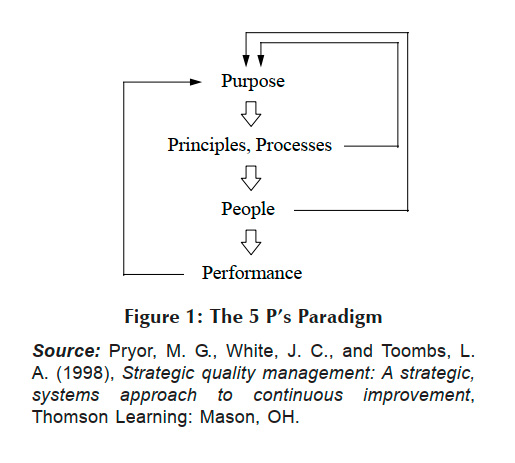
The methodology brings together five variables to improve organizations and their operations: Purpose, Principles, Process, People and Performance. The meeting of these supposedly different business disciplines seeks to increase the effectiveness of strategic implementation.
Interdependently, as the arrows in the previous graph suggest, each axis brings together a set of fields of knowledge:
• Purpose – Strategy theories
• Principles – Values and theories of organizational culture
• Process – Systems theories
• People – Behavioral theories
• Performance – Measurement and feedback theories
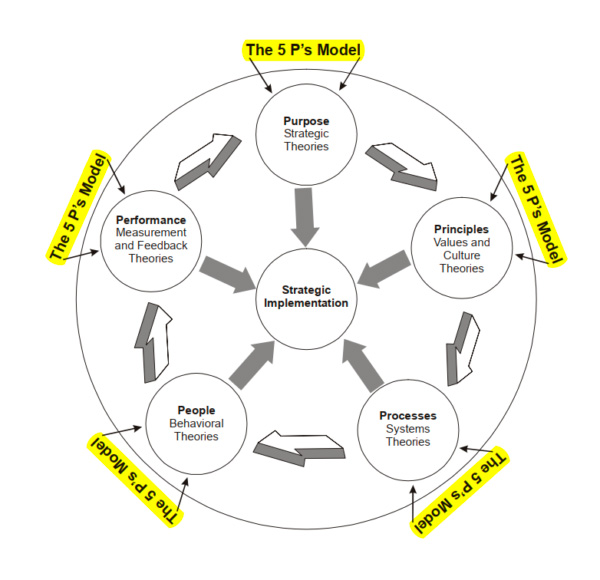
This text is the first in a series of content that we will publish for Interact, with my colleagues Iván Lasso, Fernando Estrada, Lucas Saatkamp, Jennifer Vargas, Cláudia Brentano and Damião Becker. Our goal is to promote a reflection on these five axes in the relationship between management, technology and today’s challenges.
In this specific article, I will unravel the 5P’s Strategic Implementation Model with you. In the next few, we will drill down on each of these proposals.
Purpose
What is your organization’s strategic objective? The answer to that question will define your purpose. In other words, managers must establish the north to which they want to go. To do this, they must both analyze the general objectives of the organization, as well as the strategies and specific tactics to achieve them.
This axis considers the critical factors for success, leadership skills and competitive differentials. In a cyclical movement, around the purpose we have the mission, the vision, the values, the objectives, the strategies, the tactics, the measurement of the results and the SWOT analysis.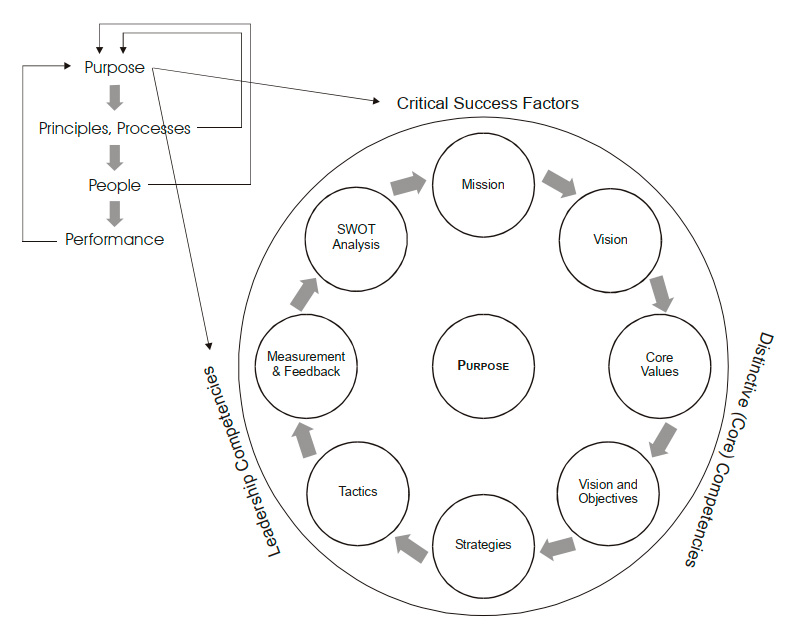
Principles
The rules of conduct and guidelines for conducting business form the principles of the organization. They are the ethical and moral references to which employees must commit.
The defined values must not be just on paper. They need to reflect on the organization’s operation, especially in the business processes. In the Principles, the authors cyclically list philosophy, attitude, ethics, basis of integrity, operating guides and agreements on behavior and main shared values.
According to the authors, the principles are connected to the processes, as shown in the graph below.
Process
The traditional view defines a process as a set of steps, where resources (people, materials, machines and methods) are transformed into products and services.
The authors advocate for a process model that includes elements such as responsibility, controls, accountability and authority. At this point in particular, the importance of the owners of the processes stands out: the employees.
A good mapping of processes, with well-defined and responsible flowcharts for each activity, will facilitate the work of documentation, management and improvement. This is essential for implementing the strategy in your organization.
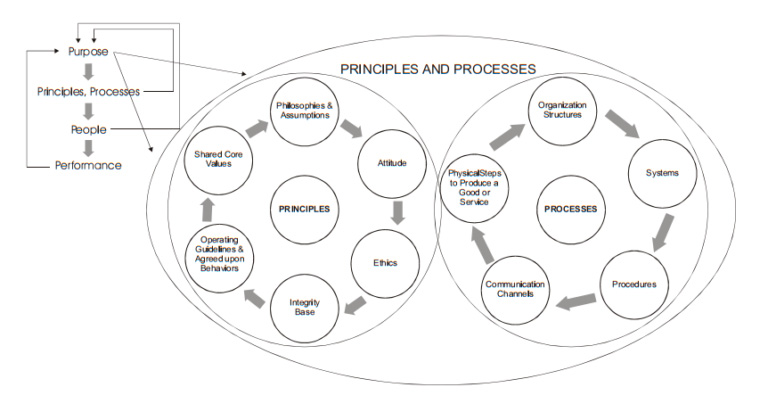
To learn more about process management, I recommend this interview with my friend Fernando Estrada, a specialist in BPM – Business Process Management:
People
For the 5P’s model, this category includes employees, customers and suppliers of the organization. As shown earlier, people are the owners of business processes, who must work based on the listed principles to achieve the organizational purpose.
Without a clear sense of belonging to the processes, stakeholders tend to fail when trying to establish effective communication. In turn, without a clear strategy in place, employees will not deliver the level of quality expected by the various stakeholders.
For the authors of the 5P’s model, the idea of process owners is controversial for those in charge of strategic execution. Although teamwork is essential to achieve success, the designation of process owners is a difficult step for many organizations, since the implementation of the strategy is commonly considered to be a unique and exclusive task of the organization’s leader.
This romanticized idea of leadership, centralized, ends up wasting the effort of employees, the real actors in the implementation of the strategy. However, if there is a comprehensive understanding of each other’s role in the organization, leaders can better align purpose, principles and processes in pursuit of high performance.
Below, I present the authors’ visual model, which brings together process stakeholders, process owners and organization leaders. At the center, people are described as teams, internal consumers, external consumers, internal suppliers, external suppliers, strengthening and individuals.
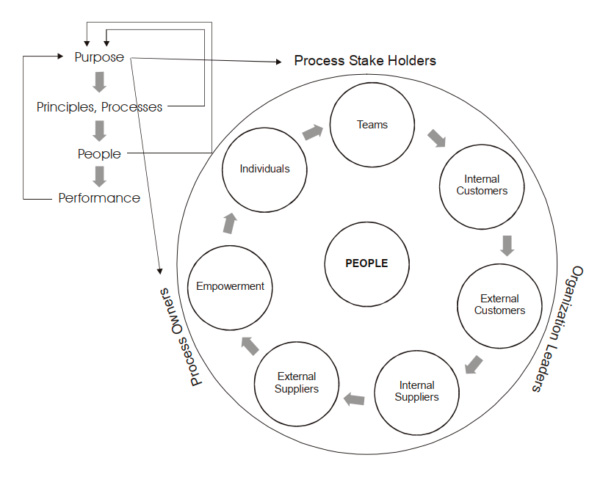
Performance
Metrics, measurements and expected results. Together they will signal the status of the organization, ensure strategic control and decision making by managers.
For the researchers, control measures should speed up continuous improvement initiatives for the organization. Measurements should help process owners understand current performance and where they can be improved.
“Progress and achievement can be seen in qualitative and quantitative terms. These two types of measures are intertwined – they clarify each other – and both are needed to shed light on how and to what extent lives are being changed ”- Peter Drucker
If the results of the improvements are positive, this is a sign that the changes are working. Likewise, if they are negative, they can signal where there are weaknesses in the organization. At that time, leaders should bring the teams together to find the best solution to the problem.
For this topic, I recommend thise-book on the PDCA method.
The visual model of the performance gathers the Key Performance Indicators (KPIs), Balanced Scorecard, baselines, target, comparison with the target and benchmarking.
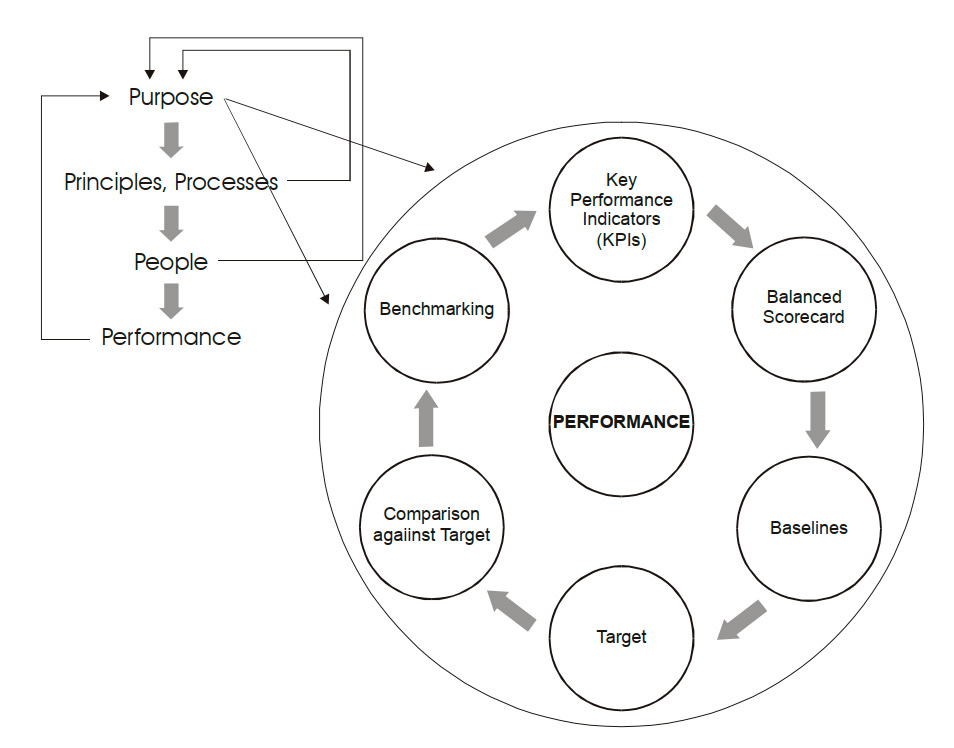
Author:
Vinícius Flôres
Journalist, Ph.D. in Communication, and martech enthusiast. Communication and Marketing Supervisor at Interact Solutions.
References
DRUCKER, Peter. As Cinco Perguntas Essenciais que Você Sempre Deverá Fazer Sobre Sua Empresa. Campus Elsevier: Rio de Janeiro, 2008.
PRYOR, Mildred Golden; ANDERSON, Donna; TOOMBS, Leslie; HUMPHREYS, John. Strategic Implementation as a Core Competency: The 5P’s Model. Journal of Management Research. Vol. 7, n. 1, April 2007.




